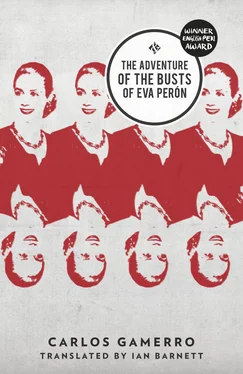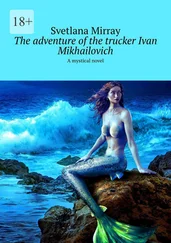Carlos Gamerro - The Adventure of the Busts of Eva Perón
Здесь есть возможность читать онлайн «Carlos Gamerro - The Adventure of the Busts of Eva Perón» весь текст электронной книги совершенно бесплатно (целиком полную версию без сокращений). В некоторых случаях можно слушать аудио, скачать через торрент в формате fb2 и присутствует краткое содержание. Год выпуска: 2015, Издательство: And Other Stories, Жанр: Современная проза, на английском языке. Описание произведения, (предисловие) а так же отзывы посетителей доступны на портале библиотеки ЛибКат.
- Название:The Adventure of the Busts of Eva Perón
- Автор:
- Издательство:And Other Stories
- Жанр:
- Год:2015
- ISBN:нет данных
- Рейтинг книги:3 / 5. Голосов: 1
-
Избранное:Добавить в избранное
- Отзывы:
-
Ваша оценка:
- 60
- 1
- 2
- 3
- 4
- 5
The Adventure of the Busts of Eva Perón: краткое содержание, описание и аннотация
Предлагаем к чтению аннотацию, описание, краткое содержание или предисловие (зависит от того, что написал сам автор книги «The Adventure of the Busts of Eva Perón»). Если вы не нашли необходимую информацию о книге — напишите в комментариях, мы постараемся отыскать её.
Carlos Gamerro's novel is a caustic and original take on Argentina's history.
The Adventure of the Busts of Eva Perón — читать онлайн бесплатно полную книгу (весь текст) целиком
Ниже представлен текст книги, разбитый по страницам. Система сохранения места последней прочитанной страницы, позволяет с удобством читать онлайн бесплатно книгу «The Adventure of the Busts of Eva Perón», без необходимости каждый раз заново искать на чём Вы остановились. Поставьте закладку, и сможете в любой момент перейти на страницу, на которой закончили чтение.
Интервал:
Закладка:
‘It’s Eva!’
‘Course it is. Who do you expect?’ the boy answered phlegmatically.
He thought at first it might be the ghost of his own María Eva, killed in combat and returning to earth in all her pomp and glory to lead the oppressed in the last battle against the forces of the anti-people; but when she looked about her at a particularly complex intersection of alleyways, and her glowing profile was silhouetted against the surrounding darkness, the difference in features became apparent; if this floating, glow-in-the-dark Eva wasn’t his very own, she could only be the real one. Dazzled, he followed her light like a moth, leaving behind the squalid shanties and crossing a dark wasteland, then climbing a long embankment — Eva with no apparent effort, Marroné slipping and sliding on the trails of muddy clay and the long water-combed grass. For a while now the chorus of frogs and crickets and the occasional barking of a dog had been joined by a continuous, monotonous hum, which he knew to be the high-speed contact of tyres on tarmac: he couldn’t be far from the freeway.
He saw her silhouette crest the embankment and nimbly vault the guard rail, pausing for a moment at the hard shoulder as if, more than the risk itself, she feared the shock her spectral apparition might cause the unsuspecting motorists; then one of her diamond-dusted shoes stepped boldly out onto the asphalt, and she strode decisively across. Haloed in the strobes of frantically flashing headlights, she shone like a comet, and, as they swerved to avoid her and the lurid red eyes of their tail lights vanished into the vaporous fog, the echoes of their horns hung in the air like ships’ sirens over water. As he followed her, meticulously treading in her footprints, he could see himself — his consciousness split like two halves of an apple — behind the wheel of one of those cars, knuckles white, eyes bulging, heart thudding in his throat. What was that? Did you see it? Was it a woman or a ghost?
Once he had negotiated the last guard rail, and before skittering down the slope of wet grass, Marroné saw where it was she was headed: about fifty metres away, brilliant white against an arc of dark cypresses that cupped them like a hand, gleamed the monumental forms of a neoclassical temple, complete with a ghostly array of statuary. Avoiding the freeway exit and the car entrance, Eva made resolutely for what turned out to be a door concealed in the privet fence surrounding the premises, and shut it behind her. Upon opening it, Marroné discovered that it led to a path laid with white gravel, which crunched softly beneath the soles of his espadrilles, and was lined with privets too tall to see over. The faint light from the waning moon gave the path a satiny sheen, and every dozen steps or so glaring Martian-green spotlights lit the bushes from below. Afraid he would lose first Eva and then himself amid this intricate maze, he quickened his pace; sometimes she would disappear for a few moments around a sharp corner or unexpected bend, but if he didn’t let her get too far ahead, her halo still shone above the privet to guide him on his way. But as luck would have it, just as he had felt confident enough to let her get a few steps ahead, a clump of grey clouds scudded across the sickle moon like a drawn curtain, and Eva’s faint phosphorescence was blown out like a candle flame. Marroné began running to catch up with her, taking the right-hand path at a fork and then, in the irrational certainty of having taken the wrong turning, retraced his steps and plunged headlong down the left-hand one, sprinting now and scratching his arms on the briars; he was still running when the maze came to an abrupt end, and he emerged onto an open lawn dotted with topiary, across which Eva glided, borne up on the dome of her skirt like a woman in a Monet painting, in the direction of the Greek temple, so close now that its imposing Doric columns seemed to lurch out at them. At this distance the resemblance, which had been clear from afar, was all the more striking: the place they were making for was a simplified scale reproduction of the Foundation named after the woman whose ghost was now climbing the broad steps to a solid bronze door. Just as she reached it, the moon reappeared, allowing Marroné to take in the topiary of privet, elaborately pruned into motifs from Peronist iconography: medallion profiles of Perón and Eva, a Peronist Party badge, a pair of hands raised skywards as if waiting to embrace all visitors. He looked away only for a few seconds but, when he turned back, he could see no trace of Eva. She had vanished, along with her halo. Marroné’s steps rang hollow among the bare columns, which turned out to be not marble, but plaster; the whole façade — including, high above, a Venus de Milo with arms, a Botticelli Venus with clothes, a Victory of Samothrace with smiling head and a Virgin Mary — bore all the familiar hallmarks of the Sansimón Plasterworks. Descending a couple of steps to get a better view of their faces, he instantly recognised in each and every one the unmistakeable features of Eva Perón. This discovery fanned a hesitant, almost extinct flame of hope: if Eva had appeared to him just when he’d thought all was lost, it was to act as his guide. But why him? Had she, too, been fooled by his current proletarian looks? Or was it precisely the opposite: that being not of this world, she could see into his soul — the soul of the Peronist child he should have been?
Fortified by these thoughts, he gave two or three firm knocks on the solid door, on which Perón’s head was sculpted in bas-relief. A peephole in the General’s face promptly opened, and when two suspicious, beady eyes peered out at him, he felt as if the General himself were inspecting him.
‘What you want?’ asked the voice within.
‘I’m looking for Eva,’ replied Marroné, without hesitation.
As if he’d hit upon the password, he heard the sliding of heavy bolts, and the door squealed open.
‘Step inside, please. Eva is expecting you. Please join the line.’
The doorman was wearing the livery of a footman in Peronist colours: light-blue Tyrolean suit embroidered with gold thread, frilly white open-necked shirt with the Party badge on the chest pocket, silk stockings and black patent-leather slippers. Marroné took his place at the end of the line. Two things surprised him. The first was the ragged appearance of his companions: there were plebs like himself, beggars and slumdogs; peasants and farmhands too, even a gaucho in full regalia; a few workers in overalls and helmets; a fat man in a leather jacket who looked like a trade unionist; and, last, a couple of toffs in impeccably tailored suits — each of them clutching a letter. The second thing he noticed was that they were all men, and adults: no women or children in sight. Oh, they must have shown in the women and children first, thought Marroné. Like the Peronist slogan went. Did it? Or was he getting it mixed up with the safety procedures for evacuating a ship? The queue wound round the corner of a corridor, then climbed a few stairs, at the top of which Eva’s office surely awaited. At first the queue hardly budged, which didn’t surprise him because Eva, as he well knew, had only just arrived; but after a few minutes she must have settled in because they started to shuffle steadily forwards.
So it was true, thought Marroné to himself. All those rumours, all those legends. Evita is among us, Evita is back. Evita is alive , just as the graffiti he’d always found so absurd claimed. She hadn’t died in ’52 — her cancer had somehow been cured; or maybe it was all a ruse to trick her enemies into believing her dead, and so the much-trumpeted corpse that had been paraded everywhere had been nothing but a simulacrum. But if that were so, Eva should be over fifty by now, and the woman he had followed down the narrow alleyways of the shanty town looked not a year older than Eva when she died — or even several years younger — but then again, many people claimed her illness had shrivelled her to the likeness of a doll. Might she have been frozen? Perhaps that had been the job of the famous Doctor Ara: to keep her dormant until a cure for her illness was found. Or what if she had actually died but her impeccably preserved body had been reanimated intact by the Umbanda rituals of Minister José López Rega, much given to dabbling in the occult, and the sleepwalking Eva he had been following was in fact a zombie? He was only too aware of how deranged these thoughts were (though in fact they were less outrageous than the tangible reality they scrabbled to explain).
Читать дальшеИнтервал:
Закладка:
Похожие книги на «The Adventure of the Busts of Eva Perón»
Представляем Вашему вниманию похожие книги на «The Adventure of the Busts of Eva Perón» списком для выбора. Мы отобрали схожую по названию и смыслу литературу в надежде предоставить читателям больше вариантов отыскать новые, интересные, ещё непрочитанные произведения.
Обсуждение, отзывы о книге «The Adventure of the Busts of Eva Perón» и просто собственные мнения читателей. Оставьте ваши комментарии, напишите, что Вы думаете о произведении, его смысле или главных героях. Укажите что конкретно понравилось, а что нет, и почему Вы так считаете.











